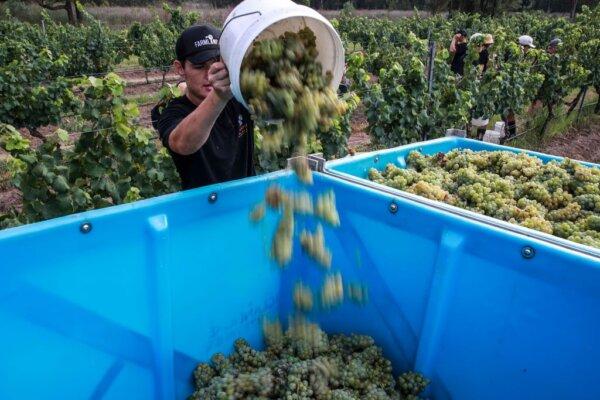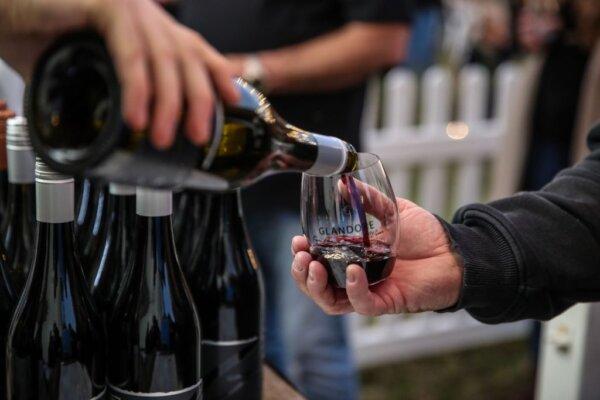Australia’s 29 percent tax on imported wine is an ‘unfair, non-reciprocal trade practice,’ according to the California Association of Winegrape Growers.
American winemakers have joined tech companies, beef producers, and pharmaceutical manufacturers in demanding U.S. President Donald Trump impose large tariffs on Australian imports.
The California Association of Winegrape Growers (CAWG) has taken issue with Australia’s 29 percent tax on imported wine, which it says is one of several “unfair, non-reciprocal trade practices” that disadvantage U.S. wine producers.
The formal complaint has been lodged with the Office of the U.S. Trade Representative, but the eventual decision will rest with the president, given Trump’s stated determination to impose tariffs as a tool to even out trade relations.
The CAWG alleges that an “influx of cheap, imported bulk wine” into America is causing vineyards and farmers—many of whom have been growing grapes for generations—to go “out of business at an alarming rate.”
The organisation admits the issue is “nuanced,” noting that not only do other countries’ tariffs disadvantage American growers, but many foreign competitors also benefit from lower production costs and “in many cases, generous public subsidies.”
It said the Australian government gives benefits to the local wine industry—including rebates, $100,000 grants, loans, and financial assistance—which “distort competition” for U.S. winemakers.
But while pleading its case to Trump, the CAWG isn’t optimistic that he’ll solve the issues they face.
“Despite the attention surrounding this latest tariff threat, it is unlikely that tariffs of this magnitude will be implemented in a sustainable or long-term manner. However, this moment presents a valuable opportunity to address the need for a level playing field for California winegrape growers,” said CAWG President Natalie Collins.

A picker empties freshly picked sémillon grapes into a crate during the harvest at Glandore Wines in the Hunter Valley in New South Wales, Australia on Jan. 11, 2024. The valley is the oldest wine-growing region in Australia, with Shiraz vines dating back to 1867. Roni Bintang/Getty Images
While bottled wines are an issue, it is bulk wine imports (finished wine shipped in large flexi-tanks, bladders, or containers) that “pose a more urgent and direct threat to California winegrowers,” the organisation said.
“Foreign bulk wine floods the U.S. at below-market prices, allowing companies to bottle and sell it under familiar ‘American’ brands, misleading consumers and undercutting domestic farmers. In 2024, an estimated 300,000 tons (272,000 tonnes) of California wine grapes went unharvested, while 38 million gallons (44 million litres) of cheap foreign bulk wine replaced California-grown grapes.
“Amid all the noise over tariffs, an actual, and very real, crisis is unfolding in California Wine Country. Winegrowers and wineries are being forced to make impossible decisions; ripping out vineyards, ending family businesses, and shutting down operations,” it says.
It also warns that any tariffs the president does decide to impose may be negated by other programmes.

President Donald Trump departs the U.S. Capitol following a Friends of Ireland luncheon in Washington on March 12, 2025. Anna Moneymaker/Getty Images
“The federal duty drawback system, in its current form, further incentivises bulk imports by allowing companies to claim refunds on import duties and excise taxes; giving imported wine a competitive advantage in the U.S. market,” CAWG says.
“This flawed program may render tariffs ineffective if companies can simply recover those costs through duty drawback.”
Australia Incentivises Wine Growing for Tourism
Australia does provide support to its wine industry.
The Wine Tourism and Cellar Door Grants Programme allows wine and cider producers to apply for grants of up to $100,000 on eligible cellar door sales.
The government has so far provided $60 million through this programme, though—while it does support grape growers—it targets cellar door sales in Australia as part of tourism promotion and does not directly affect exports.
There’s also support for research and development through the Research and Innovation (R&I) Funding programme, though this is partly funded through a levy on growers, which the government then matches.
Last year, the government also announced a one-off $3.5 million grant package to support the industry’s long-term viability after it found itself dealing with an oversupply of red wine.

Despite the popularity of bold red varieties such as Shiraz in Australia, the industry found itself with a glut of red wine last year, and received a government subsidy to help it cope. Roni Bintang/Getty Images
And Australian winemakers, along with other primary producers, can also benefit from initiatives such as $2 million in support last year for agricultural exporters to re-establish commercial connections in China and continue to diversify into other markets.
But unlike Australia, where consumption of alcohol has been steadily falling since around 1990, in America it has grown over the same period.
US Incentives for Local Growers
However, members of the CAWG also benefit from generous government assistance.
The CBMTRA (California Beverage Manufacturers Tax Relief Act) provides tax credits for wineries of all sizes, calculated based on the number of gallons produced.
The formula is: $1.00 per gallon for the first 30,000 gallons; $0.90 per gallon for gallons 30,001 to 130,000; and $0.53 per gallon for gallons 130,001 to 650,000. That applies whether or not the wine is exported.
U.S. wineries and their peak bodies can also apply for grant money, which can be used for market research and to help them determine if a particular market would benefit their business.
Original News Source Link – Epoch Times
Running For Office? Conservative Campaign Consulting – Election Day Strategies!


